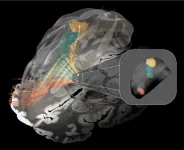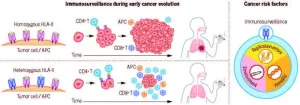(Press-News.org) CORVALLIS, Ore. – Forests in the coolest, wettest parts of the western Pacific Northwest are likely to see the biggest increases in burn probability, fire size and number of blazes as the climate continues to get warmer and drier, according to new modeling led by an Oregon State University scientist.
Understanding how fire regimes may change under future climate scenarios is critical for developing adaptation strategies, said the study’s lead author, Alex Dye.
Findings were published today in JGR Biogeosciences.
Dye, a faculty research associate in the OSU College of Forestry, and collaborators with the U.S. Forest Service conducted novel, comprehensive wildfire simulations for more than 23 million acres of forest land west of the Cascade Range crest in Oregon and Washington.
The simulations showed that by the 30-year period beginning in 2035, Washington’s North Cascades region, the Olympic Mountains, the Puget Lowlands and the western Oregon Cascades could see at least twice as much fire activity as was observed during the prior 30 years, Dye said.
To a lesser degree, that trend holds for the western Washington Cascades and the Oregon Coast Range, he added.
Forests in all of the affected areas are linchpins of multiple socio-ecological systems in the Northwest, Dye said, meaning more fire will likely put pressure on everything from drinking water sources and timber resources to biodiversity and carbon stocks.
“The moist, highly productive forests of the Northwest don’t get fire as often as other parts of the West, like California or eastern Oregon,” Dye said. “But fire does naturally occur in the PNW ‘Westside’ as we call it – the fire regimes are actually quite complex in this region. It can be challenging to assess fire probability in an environment where there isn’t a lot of empirical information about the fire history to build models.”
The comparative infrequency of fire also means it’s easy for the general public to think of the Westside as not a high-risk area, and it also means the region is generally not a focal point of studies such as the one he just completed, Dye said.
But recent big blazes such as those that occurred in the Northwest around Labor Day 2020 showed what can happen when severe fire strikes Westside areas.
“And what if fires like that were to start happening more frequently in the near future?” Dye said. “What if that once every 200 years became once every 50 years, or once every 25 years as climate change brings hotter and drier conditions to the region?”
Climate is just one factor influencing wildfire, he noted, but it is an important one. He sees the findings as a crucial planning tool to help the Northwest prepare for a rapid acceleration of fire over the next few decades.
“Describing the possibilities of how, when and where climate change could affect fire regimes helps bracket everyone’s expectations,” he said. “Particularly important among our findings are new insights into the possibility of shifts towards more frequent and large fires, especially those greater than 40,000 hectares as well as shifts toward more fires burning at the beginning of fall when extreme weather has the potential to increase fire spread.”
Forty thousand hectares is just under 99,000 acres.
Collaborating with Dye on this study were Andy McEvoy and Rebecca Lemons of the OSU College of Forestry and Matt Reilly, Karin Riley, John Kim and Becky Kerns of the Forest Service. Reilly and Kim work at the Western Wildland Environmental Threat Assessment Center in Corvallis, Kerns is at the Pacific Northwest Research Station in Corvallis, and Riley is based at the Rocky Mountain Research Center in Missoula, Montana.
The Western Wildland Environmental Threat Assessment Center and the Pacific Northwest Research Station Westside Fire Initiative supported the research.
END
Cooler, wetter parts of Pacific Northwest likely to see more fires, new simulations predict
2024-02-22
ELSE PRESS RELEASES FROM THIS DATE:
U.S. Department of Energy awards Argonne National Laboratory $4 million for energy-efficient microchip research
2024-02-22
While the microchips inside electronic devices like cell phones and computers are incredibly small, transistors — the tiny electrical switches inside of microchips — are approaching the atomic level. Today’s microchips pack over 100 million transistors in an area the size of a pin head.
Despite their almost unimaginable size, the total number of such microelectronic devices consume an enormous amount of energy, which is growing exponentially. Predictions indicate that 20% of the world’s energy could be consumed ...
Less invasive early lung cancer study receives Top 10 Clinical Research Achievement Award
2024-02-22
A Weill Cornell Medicine-led research team has been awarded a 2024 Top 10 Clinical Research Achievement Award from the Clinical Research Forum in recognition of an influential 2023 New England Journal of Medicine study on early-stage lung cancer resection.
The award is one of 10 given annually by the Clinical Research Forum for highly innovative and clinically translatable research with the potential to provide major benefits to patients. The Washington, D.C.-based organization is an influential advocate for government funding of clinical research and the interests of American clinical research institutions generally. The winners will present their award-winning ...
Releasing “brakes” in the brain
2024-02-22
When certain connections in the brain do not function correctly, disorders such as Parkinson’s disease, dystonia, obsessive-compulsive disorder (OCD), and Tourette’s syndrome may result. Targeted stimulation of specific areas in the brain can help alleviate symptoms. To pinpoint the exact therapeutic target areas of the brain, a team led by researchers from Charité – Universitätsmedizin and Brigham and Women’s Hospital analyzed data from patients across the globe who had undergone implantation of tiny electrodes to stimulate ...
JMIR Publications celebrates 25 years of publishing health research
2024-02-22
Join Gunther Eysenbach, the founder, CEO, and executive editor of JMIR Publications, in this new video as he reflects on the company's 25th anniversary and its remarkable journey in the scholarly publishing industry. Eysenbach discusses the inception of the Journal of Medical Internet Research and the driving forces behind creating an open access eHealth journal. He emphasizes the significance of innovation both in content and form, highlighting the company's early adoption of internet-based technologies ...
How discrimination, class, and gender intersect to affect Black Americans’ well-being
2024-02-22
URBANA, Ill. – Black Americans experience racial discrimination as a chronic stressor that influences their quality of life. But it exists in conjunction with other social factors that may modify the impact in various ways. A new study from the University of Illinois Urbana-Champaign explores how discrimination, gender, and social class affect individual well-being and relationship quality for Black Americans.
“It’s well documented that discrimination negatively impacts individual quality of life, but research on how it affects relationships is mixed. Some studies find it has a negative effect, others that it has no effect, and some even find a positive effect, ...
Compound vital for all life likely played a role in life’s origin
2024-02-22
Compound vital for all life likely played a role in life’s origin
A chemical compound essential to all living things has been synthesised in a lab in conditions that could have occurred on early Earth, suggesting it played a role at the outset of life, finds a new study led by UCL researchers.
The compound, pantetheine, is the active fragment of Coenzyme A. It is important for metabolism - the chemical processes that maintain life. Earlier studies failed to synthesise pantetheine effectively, leading to suggestions that it was absent at life’s origin.
In the new ...
Study reveals new insights into immune system role in lung cancer risk
2024-02-22
New York, NY (February 22, 2024)—Recent developments in cancer research have highlighted the vital role of the immune system, particularly in the notable successes of cancer immunotherapy.
Now, a paradigm-shifting study led by researchers at the Icahn School of Medicine at Mount Sinai in New York in collaboration with the University of Helsinki and Massachusetts General Hospital sheds light on how variations in immune genetics influence lung cancer risk, potentially paving the way for enhanced prevention strategies and screening.
The findings were described in the February 22 online issue of Science [DOI number: 10.1126/science.adi3808].
The investigators ...
New Cedars-Sinai study pinpoints why some injured kidneys do not heal
2024-02-22
Cedars-Sinai investigators have discovered why some injured kidneys heal while others develop scarring that can lead to kidney failure. Their findings, detailed in a paper published in the peer-reviewed journal Science, could lead to the development of noninvasive tests to detect kidney scarring and, eventually, new therapies to reverse the condition.
“The key to this discovery was our ability to directly compare injured kidney cells that successfully regenerated with those that did not,” said Sanjeev Kumar, MD, PhD, a nephrologist-scientist in the Board of Governors Regenerative Medicine Institute and the Department of Medicine at Cedars-Sinai and senior author ...
Moving “beyond Mendel” in genetics education can reduce racism, new study suggests
2024-02-22
Data from a series of randomized trials in the United States suggests that if teachers move genetics instruction toward more complex genomics concepts, they can help students have a more scientifically accurate understanding of race. This can protect students from believing in unscientific notions of genetic essentialism, including the idea that inequality is genetic. People who believe in genetic essentialism believe – among other ideas – that most racial differences are determined by genes. Essentialist ...
Uncovered with JWST: A neutron star in the remnant of Supernova 1987A
2024-02-22
Astronomers using the James Webb Space Telescope (JWST) have found conclusive evidence of a neutron star in the remnant of Supernova 1987A, the only supernova visible to the naked eye in the last 400 years and the most studied supernova in history. Although Supernova 1987A has been observed for more than three decades, scientists have not seen the compact object expected to have been produced during the explosion. Some indirect evidence had suggested that the supernova produced a neutron star, but a black hole wasn’t ruled ...





